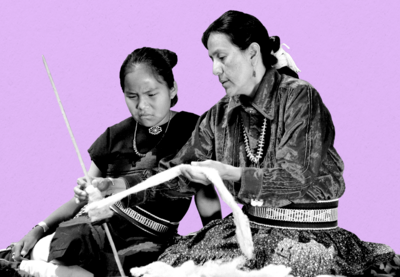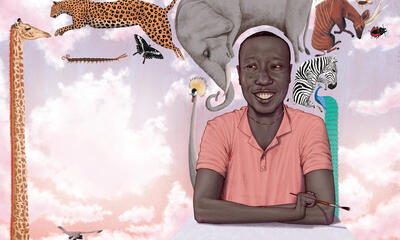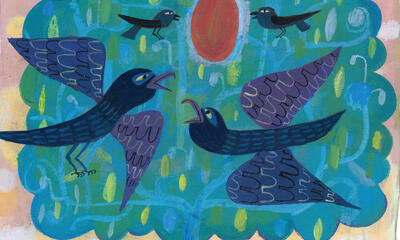Black and Indigenous people have dynamic cultures that do not begin nor end with European contact and enslavement. And Africa’s rich and diverse history is an essential part of history in the United States.
Conversations about African and Indigenous cultures are essential for learning about our history and making connections with a broader world. To complement that exploration, talking about commonalities across cultures helps children build empathy and understand identity and diversity.
This learning journey is designed from a previously published article for parents and caregivers and offers talking points and activities for children and families. We recommend exploring Identity and Commonality prior to this learning journey.
Discussing African and Indigenous Cultures
In conversations with children about Indigenous and African cultures, the following key points should be emphasized. Help children to understand that:
- Africa is a continent that has always been home to many people, nations and cultures.
- African and Indigenous people were leaders, doctors, teachers, skilled artisans, farmers and artists before they were enslaved.
- Indigenous people have a variety of cultures and have always governed their own nations in the lands that are now the United States.
- The rich cultures of Indigenous people persisted despite the colonial invasion. Many people are now working to support the resurgence of Indigenous languages and ways of seeing the world.
If the book you are reading is set in the past, make connections to the people and culture today. Emphasize that African and Indigenous cultures are not “stuck in time,” but are dynamic and changing.
Exploring the commonalities between children’s home cultures and the diverse cultures of Indigenous and African people will help children make connections and see themselves in others. In discussing other eras, cultures and nations, focus on similarities with children’s lives first before moving to discuss differences.
Talking about “cultural universals”—such as art forms, music, social organization, celebrations and basic needs—encourages children to recognize how people are bound together by similarities, regardless of group membership. Help children learn about music, arts, religion and food from a selection of nations. They might compare and contrast those experiences, asking: “What is the same about these traditions?” “What is different?” “How are these the same as and different from my culture?”
Connecting With African and Indigenous Cultures
Remember, reflecting on stories and creating art together brings joy and inspiration. These activities are not meant as assignments for children but ideas for parents, caregivers and children to do together, a “reflective sharing,” while connecting with African and Indigenous cultures.
1. Cultural Universals
Using illustrations in children’s books to highlight cultural universals and make comparisons can work well with young readers. They can identify some aspect of culture in the story and relate it to their home culture (for example, clothing, music, art, community roles). You might together create an artwork of a cultural artifact from the book along with a related one from your own culture.
2. Textiles and Culture
The rich heritage of textiles (such as blankets, quilts and cultural cloths) can connect African and Indigenous cultures and art to our own sense of identity in clothing today. Reflect on your own family's cultural heritage as reflected in textiles, clothing or jewelry. Create together a textile art project together. You can find project ideas from the National Indian Education Association or African crafts from the blog Our Ancestors.
Explore cultural heritage in your own family's textile and jewelry choices, family stories and heirlooms. And as you read stories together of places and cultures beyond the United States, have children reflect on clothing and identity and the cultural significance of textiles.
3. Story Character, Inside and Out
This activity can help young people connect with the people and cultures they read about. Similar to the Me, Inside and Out activity in the learning journey Exploring Identity and Commonality, children can complete the same process for a character in the story they’ve read or listened to. Children can draw a picture of the character and surround their images with words to add physical descriptions. They can then add more details about the character, their emotions, how they see themselves. And then in an outer circle, they can layer words that reflect aspects of the character’s home culture.
Parents and caregivers can help children complete the activity. For example, if the child is not a strong writer yet, let them tell you their thoughts and words, and you can write for them. Help children explore their own identities in relation to the character. Recognizing similarities between themselves and a character helps build understanding and empathy. To further develop this idea, a letter or note to the character helps children take a role in connecting to a story.
4. My Story Reflection
To foster literacy skills in addition to learning about cultures, help children talk about story elements, such as setting (when and where), character (who), plot and conflict (what happened), and theme (meaning or message). For example, you can discuss how the place, culture and time—the setting—adds meaning to the story. Think about the role the place plays. Talk about people in the stories and their roles in their communities. Make connections to roles today—leaders, doctors, teachers, artisans, farmers, soldiers, caregivers and more.
Creating a foldable project together can be an enjoyable way to organize responses to reading. One simple format involves using a file folder that can be folded like opening doors and then adding art and writing. You can add more to the folder by drawing and writing on it directly or by creating responses that are then glued into the folder in sections or that can fold out.
Some response ideas include:
- a drawing of the character(s) (see activity above) or character collage
- a map of the place
- a drawing of a cultural artifact
- a note to the main character
- a timeline of what happened
- a writing about the story’s message (a sentence or more, depending on the child’s ability)
- a reflection about the story that includes thoughts and feelings
- a creative response such as an artwork or a poem inspired by the story
Choosing Children’s Books
“Today—more than ever before—children from groups that have been marginalized by mainstream U.S. institutions can find books that affirm their existence.”
– Debbie Reese
Children’s books provide an engaging way of giving young people mirrors and windows to make connections with and beyond their own lives. Reading and listening to stories can, therefore, be a wonderful sharing experience for parents and caregivers to help children learn about Indigenous and African cultures.
In choosing books, it is important to recognize that authors sometimes misrepresent history and the authors’ own identities can influence what is presented. Therefore, being conscious of the perspective of the story and the author is important.
To explore African and Indigenous cultures, look for stories that center the experiences and highlight the humanity of African and Indigenous people. Try to find authors who have the lived experiences of the people and cultures about which they are writing.
Emphasizing the fullness of life and cultural experiences of African and Indigenous people can help children to later recognize ongoing racism and injustice in a nation built on a history of slavery. And as Debbie Reese pointed out: “A strong sense of justice can form in a young child’s mind when they read books that tell the truth. When they grow into adulthood, that sense of justice can guide them in how they vote and where they work.”
Resources for Children’s Books:
Social Justice Books, A Teaching for Change Project reviews multicultural and social justice books, including a resource section for talking and teaching about Africa.
American Indians in Children’s Literature provides recommendations and analyses of Indigenous people in children’s books.
Rediscovering African History, published by Our Ancestories, is a series of children’s books about pre-colonial African legends that provides activities for children to explore specific cultures.
Africa’s Great Civilizations, is a PBS series with episodes that explore various African cultures.



